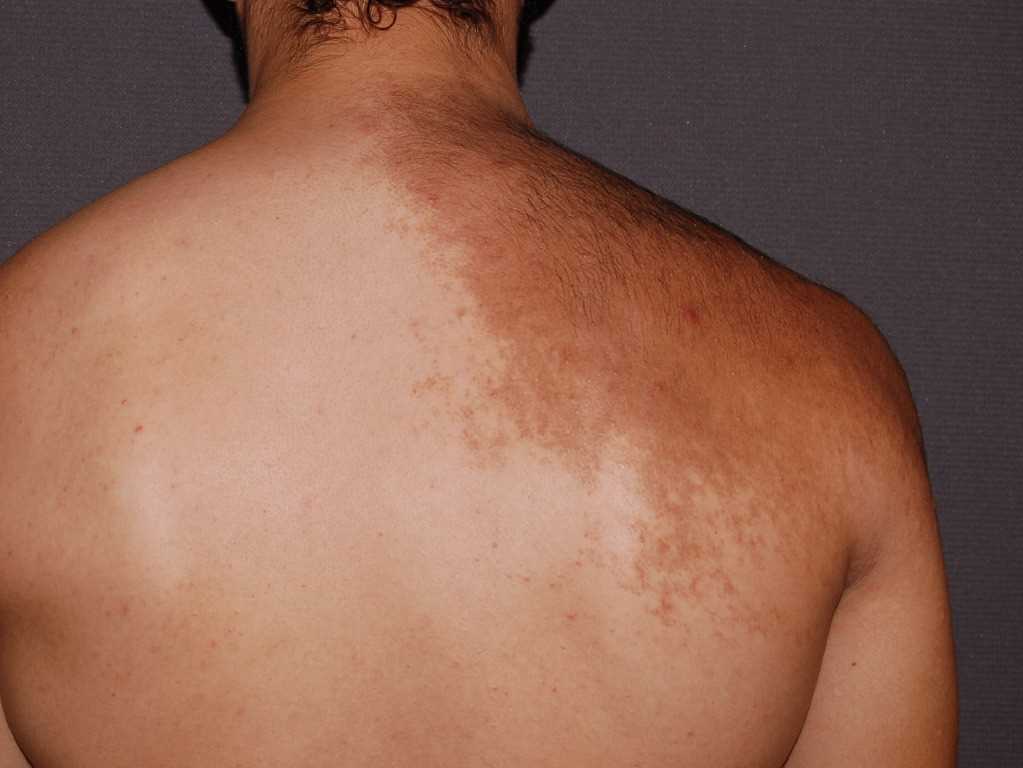[1]
BECKER SW. Concurrent melanosis and hypertrichosis in distribution of nevus unius lateris. Archives of dermatology and syphilology. 1949 Aug:60(2):155-60
[PubMed PMID: 18133444]
[2]
Patel P, Malik K, Khachemoune A. Sebaceus and Becker's Nevus: Overview of Their Presentation, Pathogenesis, Associations, and Treatment. American journal of clinical dermatology. 2015 Jun:16(3):197-204. doi: 10.1007/s40257-015-0123-y. Epub
[PubMed PMID: 25782676]
Level 3 (low-level) evidence
[3]
Patrizi A, Medri M, Raone B, Bianchi F, Aprile S, Neri I. Clinical characteristics of Becker's nevus in children: report of 118 cases from Italy. Pediatric dermatology. 2012 Sep-Oct:29(5):571-4. doi: 10.1111/j.1525-1470.2012.01734.x. Epub 2012 Apr 4
[PubMed PMID: 22471889]
Level 3 (low-level) evidence
[4]
Danarti R, König A, Salhi A, Bittar M, Happle R. Becker's nevus syndrome revisited. Journal of the American Academy of Dermatology. 2004 Dec:51(6):965-9
[PubMed PMID: 15583590]
[5]
Kim YJ, Han JH, Kang HY, Lee ES, Kim YC. Androgen receptor overexpression in Becker nevus: histopathologic and immunohistochemical analysis. Journal of cutaneous pathology. 2008 Dec:35(12):1121-6. doi: 10.1111/j.1600-0560.2008.00988.x. Epub
[PubMed PMID: 18616760]
[6]
Cai ED, Sun BK, Chiang A, Rogers A, Bernet L, Cheng B, Teng J, Rieger KE, Sarin KY. Postzygotic Mutations in Beta-Actin Are Associated with Becker's Nevus and Becker's Nevus Syndrome. The Journal of investigative dermatology. 2017 Aug:137(8):1795-1798. doi: 10.1016/j.jid.2017.03.017. Epub 2017 Mar 24
[PubMed PMID: 28347698]
[7]
Sheng P, Cheng YL, Cai CC, Guo WJ, Zhou Y, Shi G, Fan YM. Clinicopathological Features and Immunohistochemical Alterations of Keratinocyte Proliferation, Melanocyte Density, Smooth Muscle Hyperplasia and Nerve Fiber Distribution in Becker's Nevus. Annals of dermatology. 2016 Dec:28(6):697-703
[PubMed PMID: 27904268]
[8]
Dasegowda SB, Basavaraj G, Nischal K, Swaroop M, Umashankar N, Swamy SS. Becker's Nevus Syndrome. Indian journal of dermatology. 2014 Jul:59(4):421. doi: 10.4103/0019-5154.135530. Epub
[PubMed PMID: 25071279]
[9]
Manoj J, Kaliyadan F, Hiran KR. Atypical presentation of Becker's melanosis. Indian dermatology online journal. 2011 Jan:2(1):42-3. doi: 10.4103/2229-5178.79856. Epub
[PubMed PMID: 23130219]
[10]
AlGhamdi KM, AlKhalifah AI, AlSheikh AM, AlSaif FM. Clinicopathologic profile of Becker's melanosis with atypical features. Journal of drugs in dermatology : JDD. 2009 Aug:8(8):745-8
[PubMed PMID: 19663112]
[11]
Bhawan J, Chang WH. Becker's melanosis: an ultrastructural study. Dermatologica. 1979:159(3):221-30
[PubMed PMID: 478060]
[12]
Boiron G, Surlève-Bazeille JE, Maleville J. [Becker's melanosis. Study of seven cases by photonic and electron microscopy. Contribution to the histogenesis of the cytoid bodies (author's transl)]. Annales de dermatologie et de venereologie. 1980 Aug-Sep:107(8-9):787-97
[PubMed PMID: 7447258]
Level 3 (low-level) evidence
[13]
Kansal NK. Lightening Becker nevus: Role of topical therapies. Journal of the American Academy of Dermatology. 2019 Feb:80(2):e39. doi: 10.1016/j.jaad.2018.08.038. Epub 2018 Sep 6
[PubMed PMID: 30195570]
[14]
Al-Saif F, Al-Mekhadab E, Al-Saif H. Efficacy and safety of short-pulse erbium: Yttrium aluminum garnet laser treatment of Becker's nevus in Saudi patients: A pilot study. International journal of health sciences. 2017 Jul-Sep:11(3):14-17
[PubMed PMID: 28936145]
Level 3 (low-level) evidence
[15]
Momen S, Mallipeddi R, Al-Niaimi F. The use of lasers in Becker's naevus: An evidence-based review. Journal of cosmetic and laser therapy : official publication of the European Society for Laser Dermatology. 2016 Aug:18(4):188-92. doi: 10.3109/14764172.2015.1114647. Epub 2016 Mar 11
[PubMed PMID: 26735085]
[16]
Bisht YS, Bhasin R, Manoj S, Sunita BS, Singhal E. Becker's nevus syndrome. Medical journal, Armed Forces India. 2015 Jul:71(Suppl 1):S89-91. doi: 10.1016/j.mjafi.2013.04.010. Epub 2013 Aug 30
[PubMed PMID: 26265883]
[17]
Cohen PR. Poland's Syndrome: Are Postzygotic Mutations in β-Actin Associated with its Pathogenesis? American journal of clinical dermatology. 2018 Feb:19(1):133-134. doi: 10.1007/s40257-017-0330-9. Epub
[PubMed PMID: 29139054]
[18]
Ghosh SK, Majumder B, Agarwal M. Becker's nevus syndrome: a report of a rare disease with unusual associations. International journal of dermatology. 2017 Apr:56(4):458-460. doi: 10.1111/ijd.13378. Epub 2016 Sep 22
[PubMed PMID: 27655000]
[19]
Glinick SE, Alper JC, Bogaars H, Brown JA. Becker's melanosis: associated abnormalities. Journal of the American Academy of Dermatology. 1983 Oct:9(4):509-14
[PubMed PMID: 6355214]

